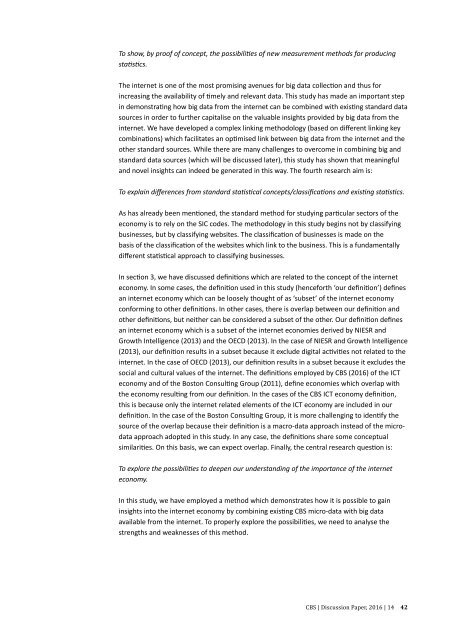Measuring the internet economy in The Netherlands a big data analysis 2016 | 14
measuring-the-internet-economy
measuring-the-internet-economy
You also want an ePaper? Increase the reach of your titles
YUMPU automatically turns print PDFs into web optimized ePapers that Google loves.
To show, by proof of concept, <strong>the</strong> possibilities of new measurement methods for produc<strong>in</strong>g<br />
statistics.<br />
<strong>The</strong> <strong><strong>in</strong>ternet</strong> is one of <strong>the</strong> most promis<strong>in</strong>g avenues for <strong>big</strong> <strong>data</strong> collection and thus for<br />
<strong>in</strong>creas<strong>in</strong>g <strong>the</strong> availability of timely and relevant <strong>data</strong>. This study has made an important step<br />
<strong>in</strong> demonstrat<strong>in</strong>g how <strong>big</strong> <strong>data</strong> from <strong>the</strong> <strong><strong>in</strong>ternet</strong> can be comb<strong>in</strong>ed with exist<strong>in</strong>g standard <strong>data</strong><br />
sources <strong>in</strong> order to fur<strong>the</strong>r capitalise on <strong>the</strong> valuable <strong>in</strong>sights provided by <strong>big</strong> <strong>data</strong> from <strong>the</strong><br />
<strong><strong>in</strong>ternet</strong>. We have developed a complex l<strong>in</strong>k<strong>in</strong>g methodology (based on different l<strong>in</strong>k<strong>in</strong>g key<br />
comb<strong>in</strong>ations) which facilitates an optimised l<strong>in</strong>k between <strong>big</strong> <strong>data</strong> from <strong>the</strong> <strong><strong>in</strong>ternet</strong> and <strong>the</strong><br />
o<strong>the</strong>r standard sources. While <strong>the</strong>re are many challenges to overcome <strong>in</strong> comb<strong>in</strong><strong>in</strong>g <strong>big</strong> and<br />
standard <strong>data</strong> sources (which will be discussed later), this study has shown that mean<strong>in</strong>gful<br />
and novel <strong>in</strong>sights can <strong>in</strong>deed be generated <strong>in</strong> this way. <strong>The</strong> fourth research aim is:<br />
To expla<strong>in</strong> differences from standard statistical concepts/classifications and exist<strong>in</strong>g statistics.<br />
As has already been mentioned, <strong>the</strong> standard method for study<strong>in</strong>g particular sectors of <strong>the</strong><br />
<strong>economy</strong> is to rely on <strong>the</strong> SIC codes. <strong>The</strong> methodology <strong>in</strong> this study beg<strong>in</strong>s not by classify<strong>in</strong>g<br />
bus<strong>in</strong>esses, but by classify<strong>in</strong>g websites. <strong>The</strong> classification of bus<strong>in</strong>esses is made on <strong>the</strong><br />
basis of <strong>the</strong> classification of <strong>the</strong> websites which l<strong>in</strong>k to <strong>the</strong> bus<strong>in</strong>ess. This is a fundamentally<br />
different statistical approach to classify<strong>in</strong>g bus<strong>in</strong>esses.<br />
In section 3, we have discussed def<strong>in</strong>itions which are related to <strong>the</strong> concept of <strong>the</strong> <strong><strong>in</strong>ternet</strong><br />
<strong>economy</strong>. In some cases, <strong>the</strong> def<strong>in</strong>ition used <strong>in</strong> this study (henceforth ‘our def<strong>in</strong>ition’) def<strong>in</strong>es<br />
an <strong><strong>in</strong>ternet</strong> <strong>economy</strong> which can be loosely thought of as ‘subset’ of <strong>the</strong> <strong><strong>in</strong>ternet</strong> <strong>economy</strong><br />
conform<strong>in</strong>g to o<strong>the</strong>r def<strong>in</strong>itions. In o<strong>the</strong>r cases, <strong>the</strong>re is overlap between our def<strong>in</strong>ition and<br />
o<strong>the</strong>r def<strong>in</strong>itions, but nei<strong>the</strong>r can be considered a subset of <strong>the</strong> o<strong>the</strong>r. Our def<strong>in</strong>ition def<strong>in</strong>es<br />
an <strong><strong>in</strong>ternet</strong> <strong>economy</strong> which is a subset of <strong>the</strong> <strong><strong>in</strong>ternet</strong> economies derived by NIESR and<br />
Growth Intelligence (2013) and <strong>the</strong> OECD (2013). In <strong>the</strong> case of NIESR and Growth Intelligence<br />
(2013), our def<strong>in</strong>ition results <strong>in</strong> a subset because it exclude digital activities not related to <strong>the</strong><br />
<strong><strong>in</strong>ternet</strong>. In <strong>the</strong> case of OECD (2013), our def<strong>in</strong>ition results <strong>in</strong> a subset because it excludes <strong>the</strong><br />
social and cultural values of <strong>the</strong> <strong><strong>in</strong>ternet</strong>. <strong>The</strong> def<strong>in</strong>itions employed by CBS (<strong>2016</strong>) of <strong>the</strong> ICT<br />
<strong>economy</strong> and of <strong>the</strong> Boston Consult<strong>in</strong>g Group (2011), def<strong>in</strong>e economies which overlap with<br />
<strong>the</strong> <strong>economy</strong> result<strong>in</strong>g from our def<strong>in</strong>ition. In <strong>the</strong> cases of <strong>the</strong> CBS ICT <strong>economy</strong> def<strong>in</strong>ition,<br />
this is because only <strong>the</strong> <strong><strong>in</strong>ternet</strong> related elements of <strong>the</strong> ICT <strong>economy</strong> are <strong>in</strong>cluded <strong>in</strong> our<br />
def<strong>in</strong>ition. In <strong>the</strong> case of <strong>the</strong> Boston Consult<strong>in</strong>g Group, it is more challeng<strong>in</strong>g to identify <strong>the</strong><br />
source of <strong>the</strong> overlap because <strong>the</strong>ir def<strong>in</strong>ition is a macro-<strong>data</strong> approach <strong>in</strong>stead of <strong>the</strong> micro<strong>data</strong><br />
approach adopted <strong>in</strong> this study. In any case, <strong>the</strong> def<strong>in</strong>itions share some conceptual<br />
similarities. On this basis, we can expect overlap. F<strong>in</strong>ally, <strong>the</strong> central research question is:<br />
To explore <strong>the</strong> possibilities to deepen our understand<strong>in</strong>g of <strong>the</strong> importance of <strong>the</strong> <strong><strong>in</strong>ternet</strong><br />
<strong>economy</strong>.<br />
In this study, we have employed a method which demonstrates how it is possible to ga<strong>in</strong><br />
<strong>in</strong>sights <strong>in</strong>to <strong>the</strong> <strong><strong>in</strong>ternet</strong> <strong>economy</strong> by comb<strong>in</strong><strong>in</strong>g exist<strong>in</strong>g CBS micro-<strong>data</strong> with <strong>big</strong> <strong>data</strong><br />
available from <strong>the</strong> <strong><strong>in</strong>ternet</strong>. To properly explore <strong>the</strong> possibilities, we need to analyse <strong>the</strong><br />
strengths and weaknesses of this method.<br />
CBS | Discussion Paper, <strong>2016</strong> | <strong>14</strong> 42





